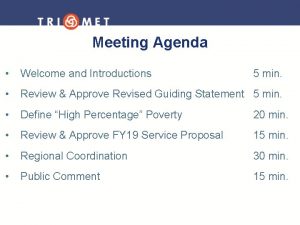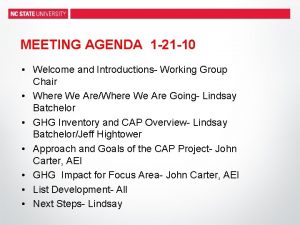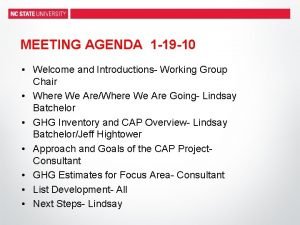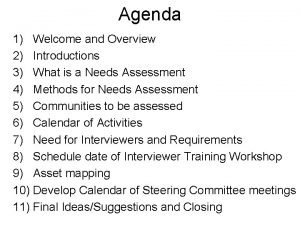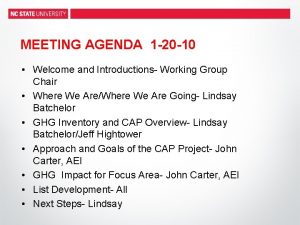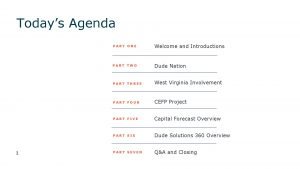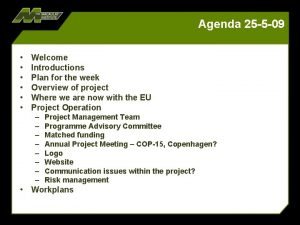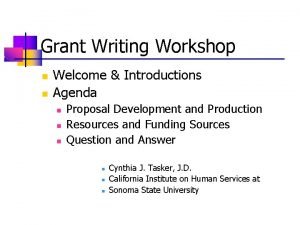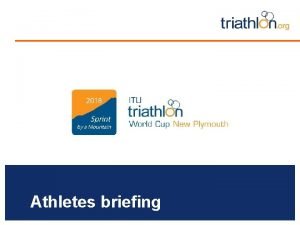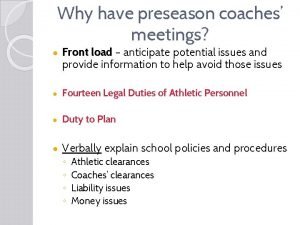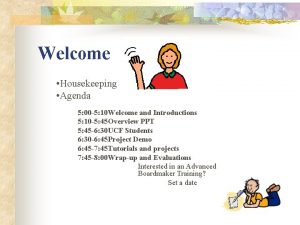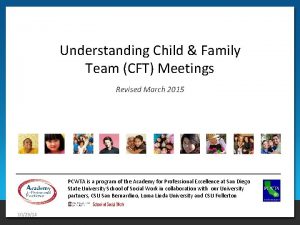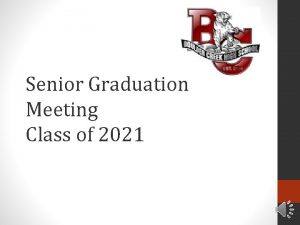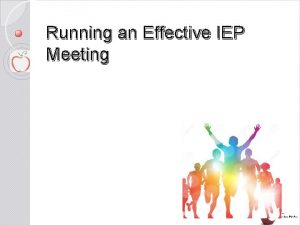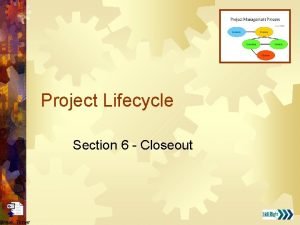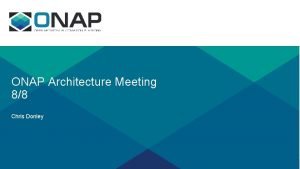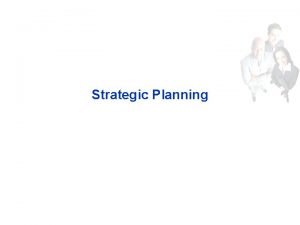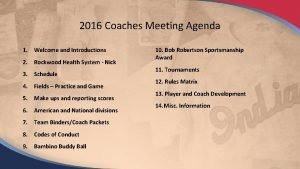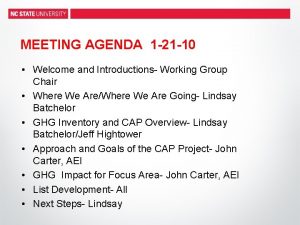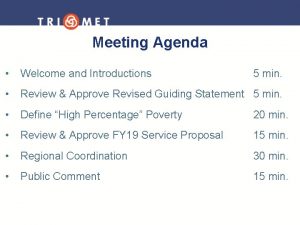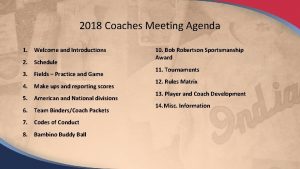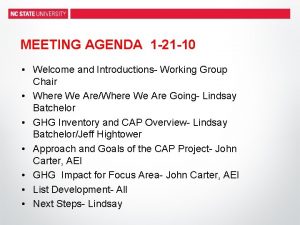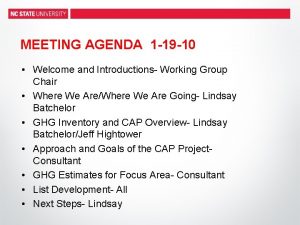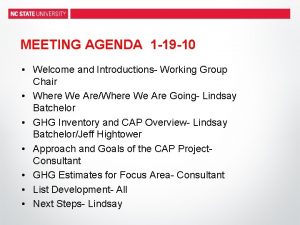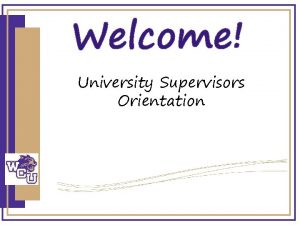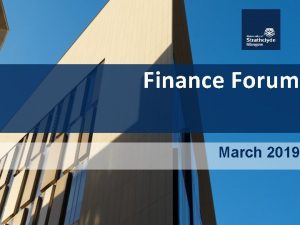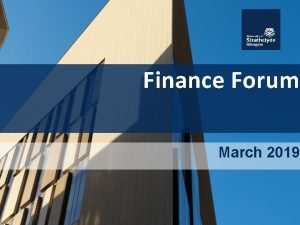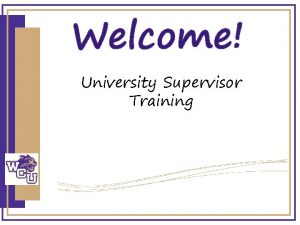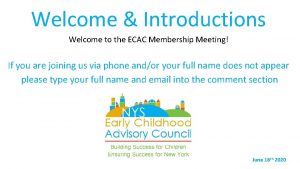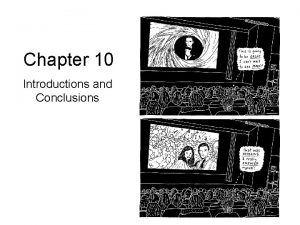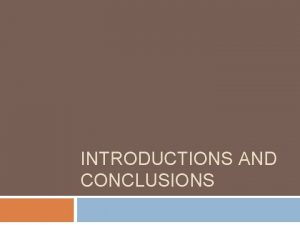MEETING AGENDA 1 19 10 Welcome and Introductions

























- Slides: 25

MEETING AGENDA 1 -19 -10 • Welcome and Introductions- Working Group Chair • Where We Are/Where We Are Going- Lindsay Batchelor • GHG Inventory and CAP Overview- Lindsay Batchelor/Jeff Hightower • Approach and Goals of the CAP Project. Consultant • GHG Estimates for Focus Area- Consultant • List Development- All • Next Steps- Lindsay

UPDATE ON PLANNING PROGRESS

SUSTAINABILITY STRATEGIC PLAN Climate Action Plan Energy & Water Land Use Buildings Academics & Research Materials & Purchasing Transportation Waste Reduction & Recycling

CLIMATE IMPACT AT NC STATE UNIVERSITY

AMERICAN COLLEGE AND UNIVERSITY PRESIDENTS CLIMATE COMMITMENT • Addresses global warming through a commitment to work towards climate neutrality • Co-organized by AASHE, eco. America and Second Nature • Over 650 signatories nation-wide • NC State signed the ACUPCC in 2008

REQUIREMENTS OF THE ACUPCC • Within two months of signing this document, create institutional structures to guide the development and implementation of the plan • Within one year complete a comprehensive inventory of greenhouse gas (GHG) emissions and update the inventory every other year thereafter • Within two years of signing this document, develop an institutional action plan for becoming climate neutral • Initiate two or more tangible actions to reduce greenhouse gases while the more comprehensive plan is being developed • Make the action plan, inventory, and periodic progress reports publicly available Source- http: //www. presidentsclimatecommitment. org/html/commitment. php

NC STATE UNIVERSITY’S TANGIBLE ACTIONS • U. S Green Building Council’s LEED Silver Standard or equivalent • U. S. EPA’s ENERGY STAR Partner • Provide access to public transportation

WHAT IS A GHG EMISSIONS INVENTORY? For the purposes of the ACUPCC, a GHG inventory quantifies your campus “carbon footprint” in terms of metric tons of carbon dioxide equivalent per year (MTe. CO 2/yr)

NC STATE GHG EMISSIONS INVENTORY • WHO: Jeff Hightower- Director of Utilities Infrastructure for Facilities Operations and student interns • WHEN: Time Frame- Data from both 2008 calendar year and 2007/2008 Fiscal Year • WHERE: Boundaries- Main Campus, Centennial Biomedical Campus and some satellite offices • HOW: Calculators- Clean Air, Cool Planet; Climate Registry; EPA; Atmosfair

GHG EMISSIONS INVENTORY- SCOPES

GHG EMISSIONS INVENTORY- 2008


CLIMATE ACTION PLANNING

WHAT IS A CLIMATE ACTION PLAN? • A comprehensive plan including a target date and interim milestones for how NC State will reach climate neutrality • Will include the following sections: • Introduction • Campus Emissions • Mitigation Strategies • Educational, Research and Community Outreach Efforts • Financing • Tracking Progress

THE CARBON MANAGEMENT HIERARCHY Avoid Reduce Replace Offset Avoid carbon-intensive activities (and rethink business strategy) Do whatever you do more efficiently Replace high-carbon energy sources with low-carbon energy ones Offset those emissions that cannot be eliminated by the above Modified Version from “Getting to Zero: Defining Corporate Carbon Neutrality” by Clean Air – Cool Planet

STABILIZATION TRIANGLE (PACALA-SOCOLOW) Graph from the Princeton Environmental Institute’s “Stabilization Wedges: A Concept and Game”

STABILIZATION WEDGES (PACALA-SOCOLOW) Graph from the Princeton Environmental Institute’s “Stabilization Wedges: A Concept and Game”

ACTUAL EXAMPLE – DUKE UNIVERSITY

Traditional valuation Climate Action Plan

Value when GHG has a price Climate Action Plan

CAP WEDGE GROUPS • • • Green Development (campus growth, new buildings) Energy Conservation (existing buildings) Fuel Mix and Renewable Energy Transportation (commuting, business travel, fleet) Offsets (off-campus carbon reduction) *Base Case • Define “business as usual” assumptions across all wedges • Estimate “do-nothing” cost associated with GHG emissions


AEI APPROACH Phase 1 Phase 2

LAND USE GHG IMPACT • Plug Loads – Approx. 10% of overall GHG emissions • Green IT – Possible 20% of overall GHG emissions – Purchasing an important piece • Sustainable Purchasing – Transport of materials • Student Education – Purchasing energy efficient electronics

MATERIALS AND PURCHASING STRATEGIES • Develop a sustainable purchasing policy for campus that will provide goals and direction for how to foster environmentally and socially responsible purchasing. • Help individual department further develop the University’s sustainability policy to focus on their specific needs • Help campus increase the amount of sustainable materials purchased. • Develop a tracking system for sustainable purchases on campus. • Work with Market. Place vendors to highlight sustainable items on their electronic ordering sites. • Develop bid specifications that require vendors to provide sustainable options for their products such as reduction of packing materials for items shipped to campus.
 Agenda welcome and introductions
Agenda welcome and introductions Agenda welcome and introductions
Agenda welcome and introductions Meeting agenda welcome and introductions
Meeting agenda welcome and introductions Meeting agenda welcome and introductions
Meeting agenda welcome and introductions Agenda welcome and introductions
Agenda welcome and introductions Agenda welcome and introductions
Agenda welcome and introductions Agenda welcome and introductions
Agenda welcome and introductions Agenda welcome and introductions
Agenda welcome and introductions Agenda welcome and introductions
Agenda welcome and introductions Agenda welcome and introductions
Agenda welcome and introductions Agenda welcome and introductions
Agenda welcome and introductions Agenda welcome and introductions
Agenda welcome and introductions Agenda sistemica y agenda institucional
Agenda sistemica y agenda institucional What is meeting and types of meeting
What is meeting and types of meeting Types of meeting
Types of meeting Preseason coaches meeting agenda
Preseason coaches meeting agenda Housekeeping agenda
Housekeeping agenda Football coaches meeting agenda
Football coaches meeting agenda Cft meetings
Cft meetings Meeting objective
Meeting objective Graduation meeting agenda
Graduation meeting agenda Iep meeting agenda
Iep meeting agenda Close out project
Close out project Introductory meeting agenda
Introductory meeting agenda Architecture meeting agenda
Architecture meeting agenda Agenda for mentoring session
Agenda for mentoring session
